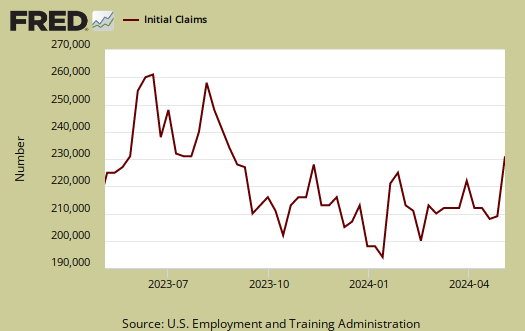Initial weekly unemployment claims for the week ending on December 31st, 2011 were 372,000. The DOL reports this as a decrease of 15,000 from last week. The previous report, two weeks ago due to the holiday, was revised, from 387,000 from 381,000, an increase of 6,000. Initial unemployment claims are well below the magic 400,000 number, which indicates any job growth. The week of February 26th, 2011, initial unemployment claims were 375,000.

Every week initial unemployment claims are revised. One simply cannot compare the reported numbers on a week to week basis due to the lag in States reporting claims data and revisions, plus the fact this is a 1 week time window, versus a monthly one. One needs to at minimum look at the 4-week moving average, which is also below the magic 400,000 number, 373,250.
Below is the 4 week moving average, set to a logarithmic scale to remove even more statistical noise, for the last year. We have a clear downward trend, which is good news. The initial unemployment report is indicating moderate to modest job growth.

The magic number to show job creation is at minimum, below 400,000 initial unemployment claims, per week. Most Economists will quote 375,000 as the magic number to indicate job growth.
Below is the mathematical log of initial weekly unemployment claims, so one can get a better sense of the rise and fall of the numbers. A log helps remove some statistical noise, it's kind of an averaging. As we can see we have a step rise during the height of the recession, but then a leveling where every week initial unemployment insurance claims hover around 400,000, refusing to really drop, a never ending labor malaise for most of the time after the recession ended in July 2009. What we need to see here is a steep decline over time to get a really Merry Christmas and a good new year.

Below is the 4 week moving average, set to a log scale, from April 1st, 2007. We are nowhere near pre-recession initial weekly unemployment claims levels. Yet we can see how much improved the numbers are. Of course everyone in America should have been fired at least once by now.

Weekly initial unemployment claims are statistically noisy, the numbers are always revised, there is large variance because it's a weekly data report instead of monthly, and only through a long term pattern can one say anything about the unemployment situation. While this report is great news, what we want to see is a strong trend. It will take a few more months before we can declare one.
Continuing unemployment claims dropped but bear in mind people can plain being running out of benefits.
The advance number for seasonally adjusted insured unemployment during the week ending December 24, was 3,595,000, a decrease of 22,000 from the preceding week's revised level of 3,617,000. The 4-week moving average was 3,601,750, a decrease of 1,000 from the preceding week's revised average of 3,602,750.
In the week ending December 17th, not seasonally adjusted, the raw number was 7,223,203 official people obtaining some sort of unemployment insurance benefit. Officially, there are 13.303 million unemployed and if one takes all of the people who want a job, including those stuck in part-time because they can't get anything else, the number is over 28 million. These numbers should change tomorrow with the December unemployment report release, but regardless, it takes years of job growth to generate 30 million more jobs.

Recent comments